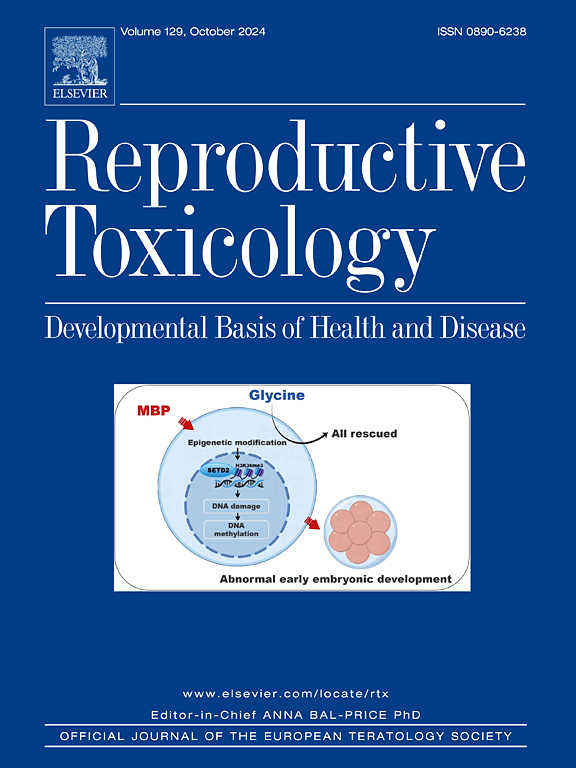In utero benzene exposure in CD-1 mice results in increased fetal and placental size at gestational day 19, which is dependent upon intra-litter variables
IF 3.3
4区 医学
Q2 REPRODUCTIVE BIOLOGY
引用次数: 0
Abstract
Benzene is a common environmental pollutant and carcinogen. In a previous mouse study, we found that transplacental benzene exposure increased tumor incidence in offspring, with apparent sex differences. Mouse models are widely used in developmental toxicity studies; however, they are litter-bearing and show intra-litter variability. This study sought to determine if in utero benzene exposure affects fetal and placental growth with consideration for intra-litter variables. Pregnant CD-1 mice were exposed to corn oil (vehicle control) or 200 mg/kg benzene from gestational days (GD) 8–14 and sacrificed on GD 19. Fetal-placental units were grouped by exposure, sex, and uterine horn location. Fetus and placenta growth measurements were normalized to maternal weight gain and total live litter size or the number of live fetuses in the uterine horn. In utero benzene exposure did not affect fetal survival or the distribution of fetuses between sexes or uterine horns, but did significantly increase fetal and placental size, particularly in the left uterine horn. Both male and female fetuses showed increased weight, head-rump length, head circumference, and abdominal circumference, with the left horn most affected. Placental weight and diameter also increased, with larger placentas in the left horn. Fetal heart weight increased, especially in female fetuses. Placental efficiency was not significantly altered, though benzene-exposed females had higher efficiency than males. These findings suggest that benzene induces placental toxicity, leading to altered growth, and emphasize the need to account for intra-litter variability in xenobiotic-induced developmental toxicity studies.
CD-1小鼠子宫内苯暴露导致妊娠第19天胎儿和胎盘大小增加,这取决于胎内变量
苯是一种常见的环境污染物和致癌物。在先前的一项小鼠研究中,我们发现经胎盘苯暴露会增加后代的肿瘤发病率,并存在明显的性别差异。小鼠模型广泛用于发育毒性研究;然而,它们携带凋落物,并表现出凋落物内部的变异性。本研究旨在确定子宫内苯暴露是否会影响胎儿和胎盘的生长,并考虑到胎内变量。将妊娠CD-1小鼠从妊娠第8 ~ 14天开始暴露于玉米油(对照)或200 mg/kg苯中,并于妊娠第19天处死。胎儿胎盘单位按暴露、性别和子宫角位置分组。胎儿和胎盘生长测量标准化为母体体重增加和总活产仔数或子宫角内活胎数。子宫内苯暴露不影响胎儿存活,也不影响胎儿性别分布或子宫角,但确实显著增加胎儿和胎盘的大小,尤其是左侧子宫角。男女胎儿均表现出体重、头臀长、头围和腹围增加,以左角受影响最大。胎盘重量和直径也增加,左角的胎盘较大。胎儿心脏重量增加,尤其是女性胎儿。胎盘效率没有显著改变,但接触苯的雌性胎盘效率高于雄性。这些发现表明,苯诱导胎盘毒性,导致生长改变,并强调在外源性诱导的发育毒性研究中需要考虑产仔内的变异性。
本文章由计算机程序翻译,如有差异,请以英文原文为准。
求助全文
约1分钟内获得全文
求助全文
来源期刊

Reproductive toxicology
生物-毒理学
CiteScore
6.50
自引率
3.00%
发文量
131
审稿时长
45 days
期刊介绍:
Drawing from a large number of disciplines, Reproductive Toxicology publishes timely, original research on the influence of chemical and physical agents on reproduction. Written by and for obstetricians, pediatricians, embryologists, teratologists, geneticists, toxicologists, andrologists, and others interested in detecting potential reproductive hazards, the journal is a forum for communication among researchers and practitioners. Articles focus on the application of in vitro, animal and clinical research to the practice of clinical medicine.
All aspects of reproduction are within the scope of Reproductive Toxicology, including the formation and maturation of male and female gametes, sexual function, the events surrounding the fusion of gametes and the development of the fertilized ovum, nourishment and transport of the conceptus within the genital tract, implantation, embryogenesis, intrauterine growth, placentation and placental function, parturition, lactation and neonatal survival. Adverse reproductive effects in males will be considered as significant as adverse effects occurring in females. To provide a balanced presentation of approaches, equal emphasis will be given to clinical and animal or in vitro work. Typical end points that will be studied by contributors include infertility, sexual dysfunction, spontaneous abortion, malformations, abnormal histogenesis, stillbirth, intrauterine growth retardation, prematurity, behavioral abnormalities, and perinatal mortality.
 求助内容:
求助内容: 应助结果提醒方式:
应助结果提醒方式:


